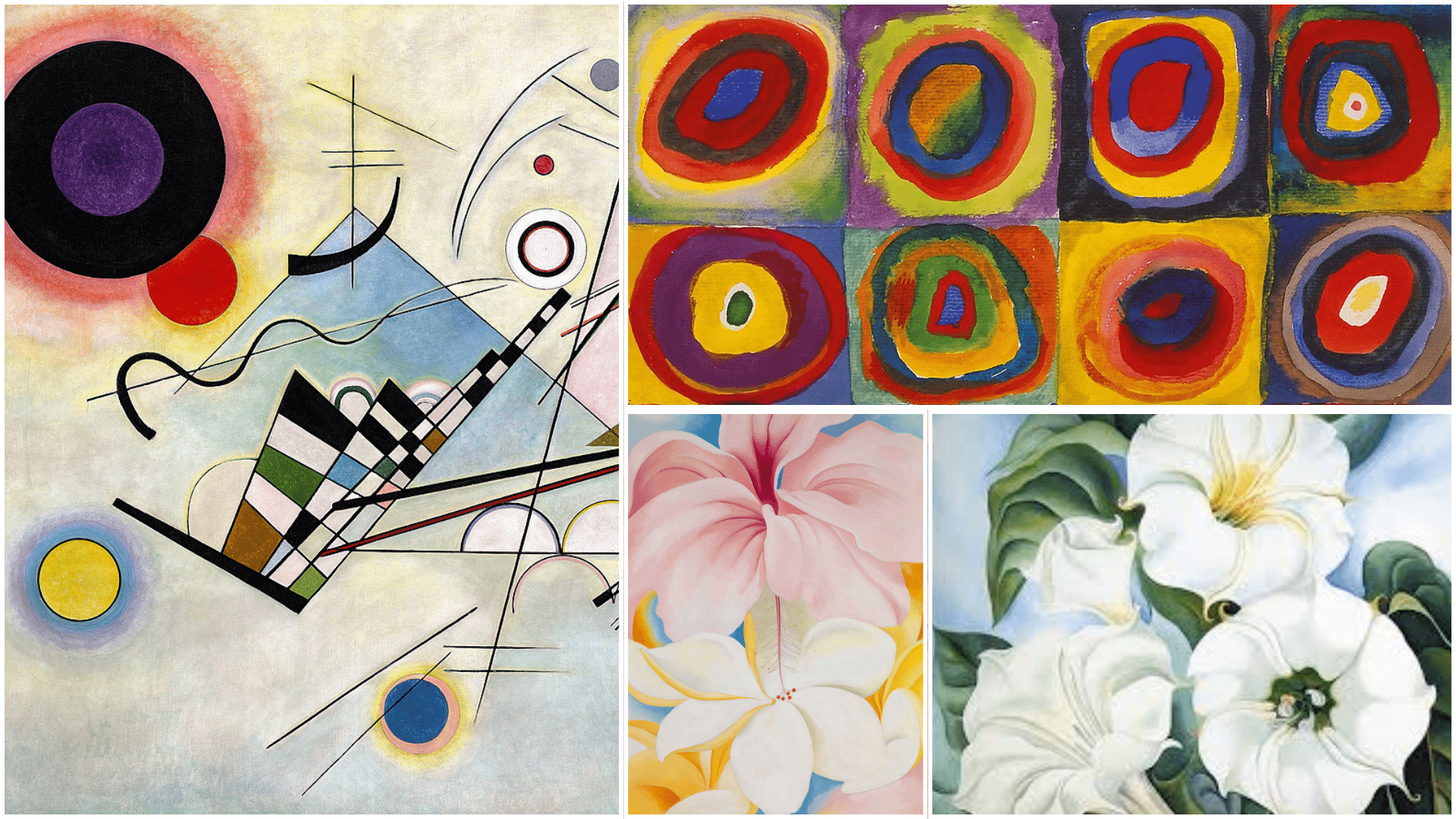When you first look at a painting, you might wonder why your eyes move in a certain direction or why some artworks feel more alive than others.
The mind constantly asks: What makes this artwork feel connected? Why does it seem to flow? How does the artist guide where I look?
These questions find their answers in understanding rhythm, one of the most important principles that artists use to create movement, unity, and energy in their work.
Just as music has rhythm that makes listeners want to move, visual art has rhythm that guides the eye and creates emotional responses.
Learning about rhythm helps viewers appreciate how artists carefully arrange elements to create these powerful effects.
Understanding Rhythm in Art: Definition and Importance
Rhythm in art refers to the visual pattern created when shapes, elements, colors, or movements repeat throughout a work.
Think of it as the heartbeat of an artwork; a steady or varied pulse that moves across the canvas or sculpture.
Artists use rhythm to create flow and movement within their compositions, connecting different parts and drawing attention to specific areas.
When elements repeat thoughtfully, they create paths for the eye to follow, making the viewing experience more engaging.
Understanding why rhythm matters reveals its true power in artistic creation. Rhythm brings harmony to artworks by connecting separate elements through repetition, creating unity so all parts feel like they belong together.
The principle also adds energy to static images through careful repetition and variation, making paintings and sculptures feel alive with movement.
Most importantly, rhythm guides the viewer’s eye through the composition, creating visual pathways that control how people experience the work and what emotions they feel along the way.
Art Gallery: Rhythm in Art Examples
The following masterworks demonstrate how different artists have used rhythm to create powerful visual effects.
These rhythm examples in art showcase the diverse ways artists employ this principle across different styles and periods:
1. The Dance by Henri Matisse (1910)
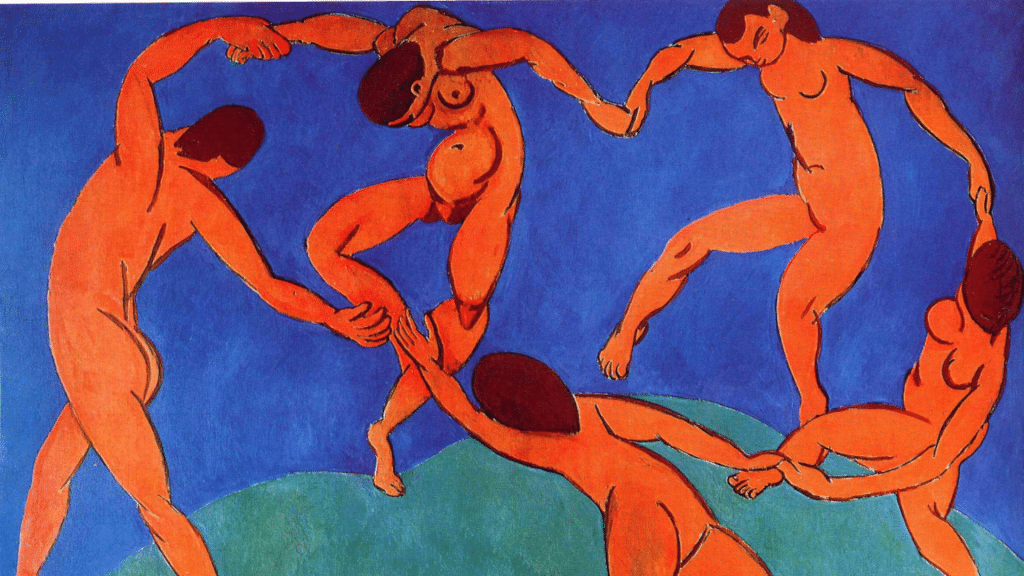
Observe how the linked dancers form a continuous circle that your eye follows around the canvas. The repeated human figures create a steady beat, while their connected poses maintain the flowing rhythm.
The consistent use of warm colors reinforces this sense of unified movement.
2. The Four Trees by Claude Monet (1891)
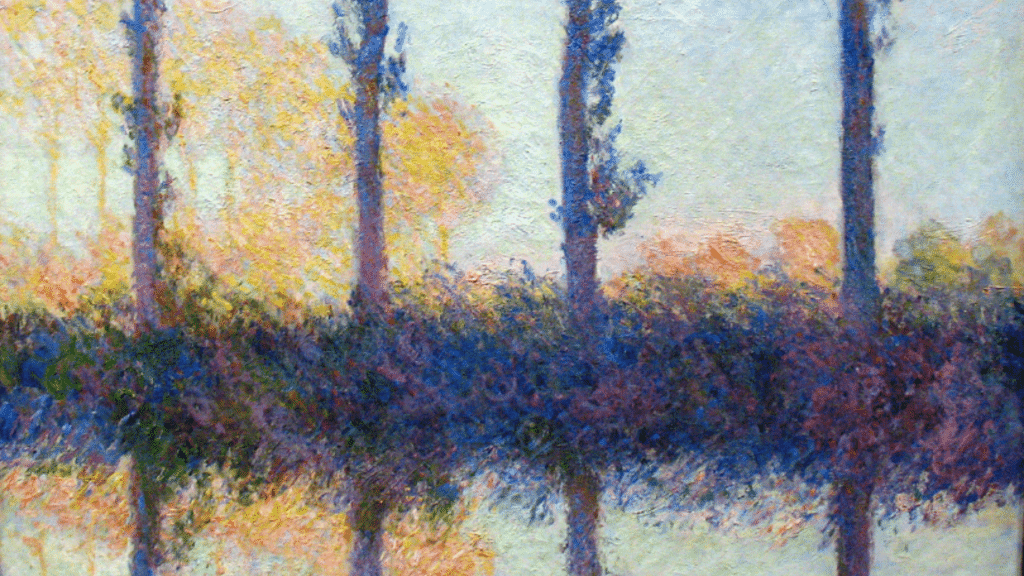
Look at how the four trees are evenly spaced across the canvas, creating a steady vertical rhythm. Each tree varies slightly in shape and color, adding visual interest while maintaining the pattern.
This regular spacing creates a calm, predictable rhythm that feels natural and harmonious.
3. Pine Forest by Ivan Shishkin (1872)
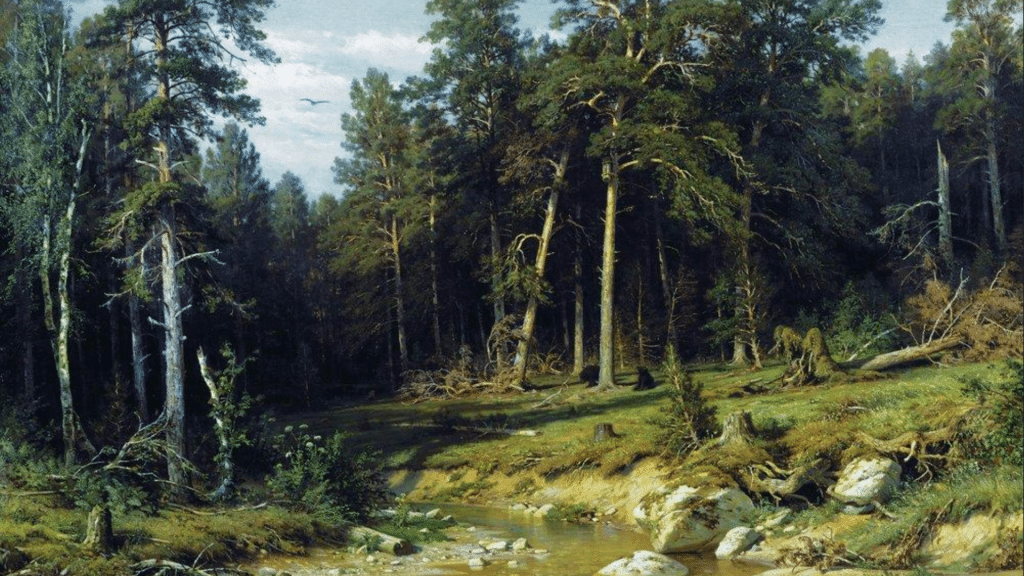
See how the tall tree trunks repeat vertically throughout the composition, establishing a strong upward rhythm.
The consistent vertical lines create a sense of order and stability within the forest scene. The slight variations in trunk thickness and spacing prevent monotony while maintaining the rhythmic pattern.
4. Parade by Jacob Lawrence (1960)
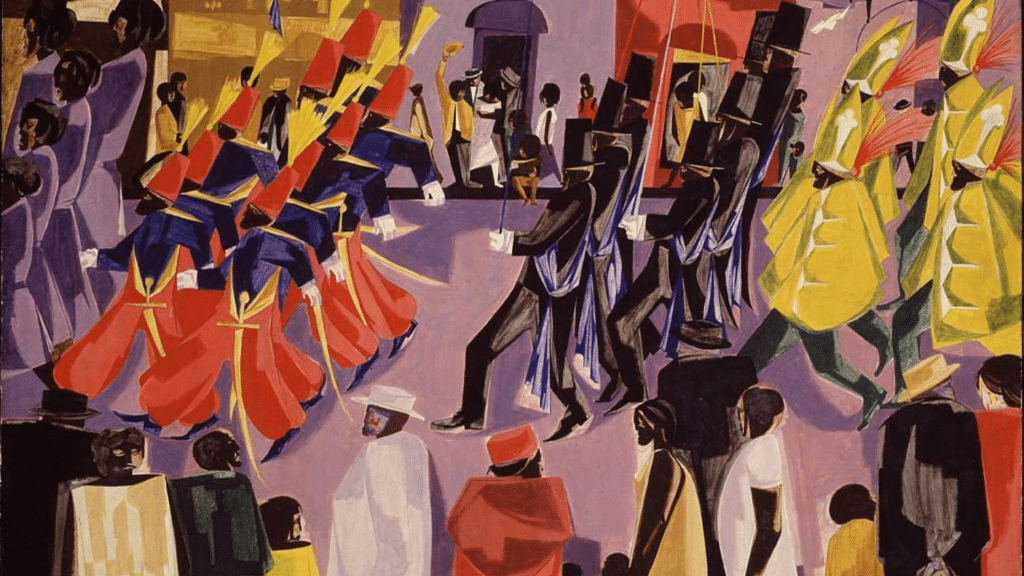
Notice how geometric shapes and bright colors alternate throughout the composition, creating an energetic visual beat. The repeated patterns of figures and objects establish a lively rhythm that suggests movement and celebration.
The contrasting colors enhance this rhythmic effect by creating visual accents at regular intervals.
5. Untitled by Donald Judd (1967/1968)
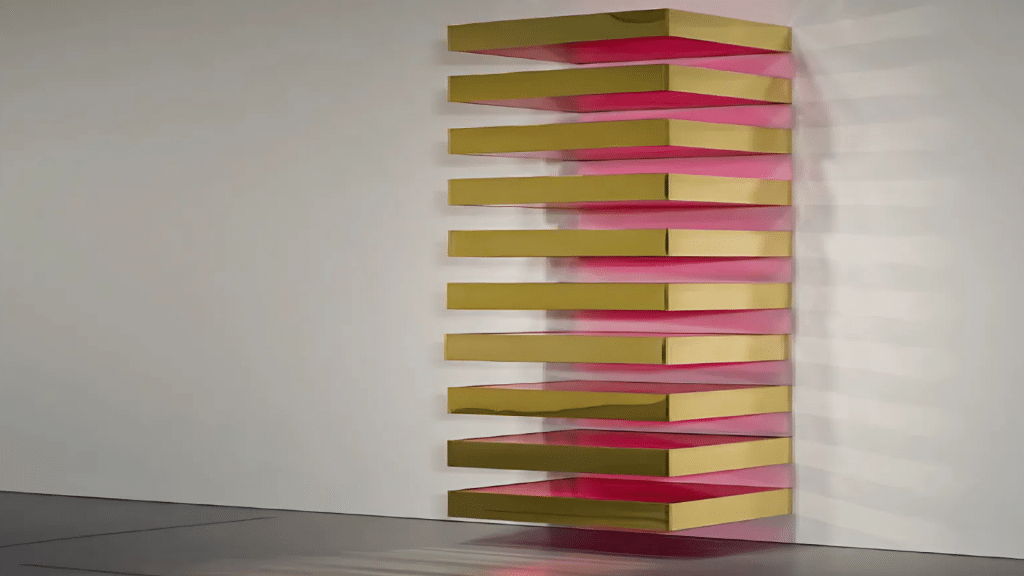
Observe how the identical geometric forms are placed at equal intervals, creating a calm, predictable rhythm.
The repetition of the same shape and spacing establishes a minimalist beat that feels orderly and controlled. This regular pattern creates a meditative quality that draws attention to the relationship between form and space.
6. The Scream by Edvard Munch (1893)
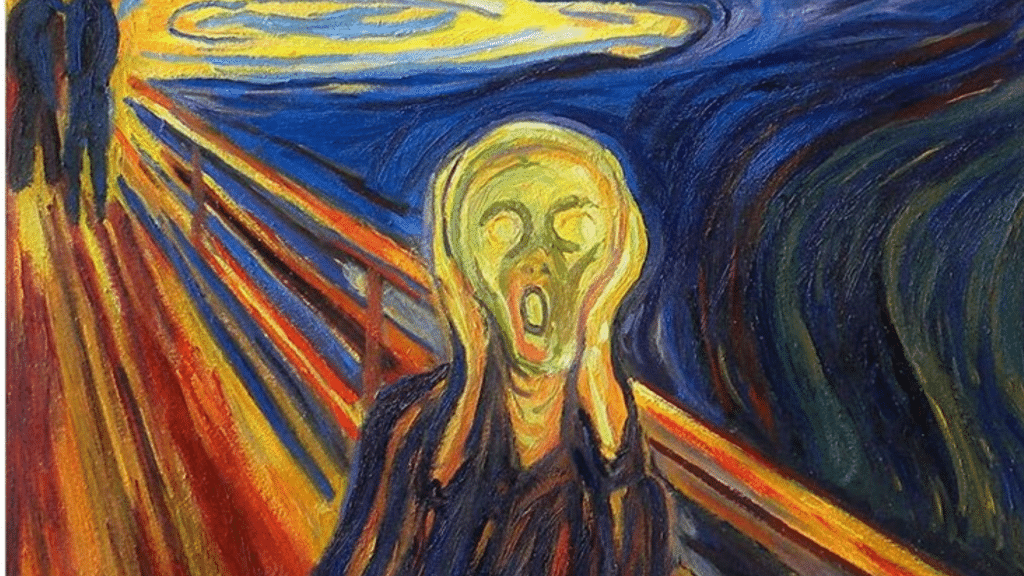
Look at how the swirling lines flow across the sky and water, creating a turbulent, emotional rhythm. The curved forms repeat in wavelike patterns that seem to pulse with anxiety and movement.
This flowing rhythm enhances the painting’s psychological impact by making the entire landscape appear to vibrate with emotion.
7. “Water Lilies” by Claude Monet (1916-1919)
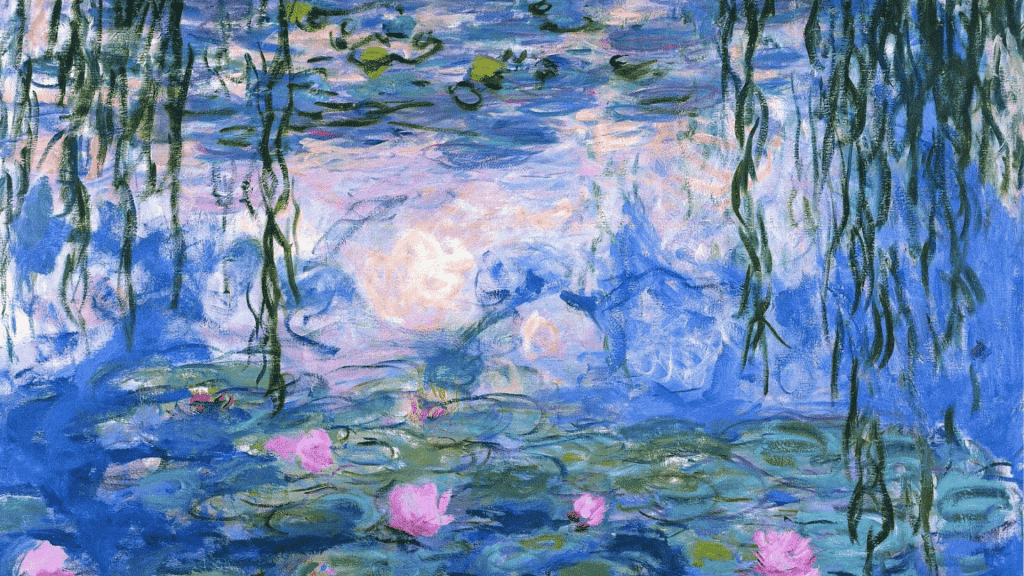
Look at how the lily pads repeat across the water’s surface in organic clusters and patterns.
The brushstrokes create a flowing rhythm that mimics the gentle movement of water, while the scattered lily forms establish points of visual accent.
This natural rhythm feels both random and purposeful, creating a sense of peaceful movement.
Types of Rhythm in Art
Now that the concept of rhythm is clear, the next question naturally arises: how many different ways can artists create it?
Just as musicians use different rhythmic patterns to create various moods and feelings, visual artists employ distinct types of rhythm to achieve specific effects in their work.
These rhythm examples in art demonstrate the versatility and power of this fundamental principle.
1. Regular Rhythm
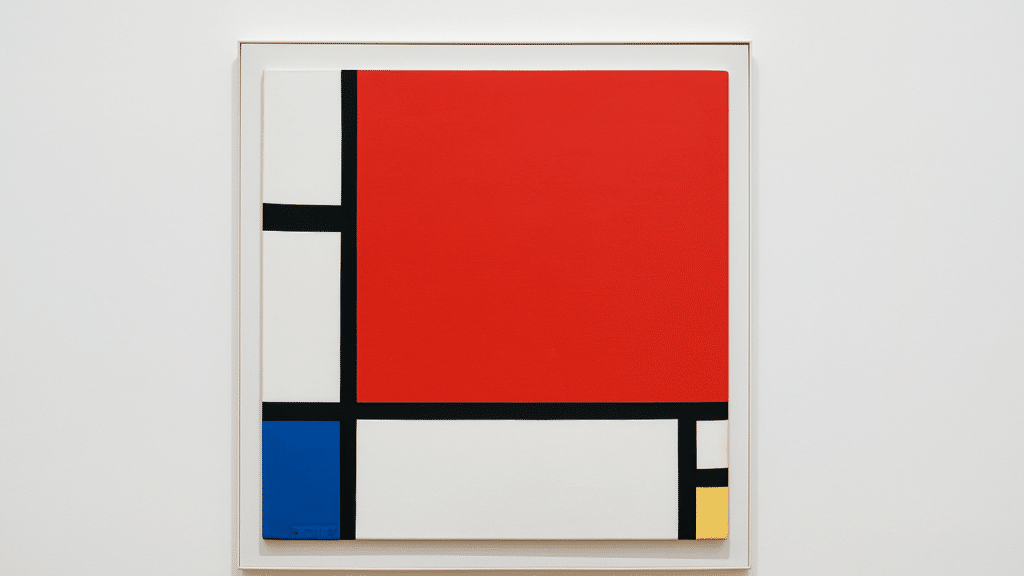
Composition II in Red, Blue, and Yellow, 1930 by Piet Mondrian
Regular rhythm appears when elements repeat in systematic, orderly patterns.
This creates a sense of stability and predictability, much like a steady drumbeat in music. The elements maintain consistent spacing, size, and appearance throughout the composition.
Piet Mondrian’s “Composition II in Red, Blue, and Yellow” perfectly demonstrates this approach. Look at how the black lines create a grid that repeats at regular intervals across the canvas.
Notice how the colored rectangles appear in measured spaces, creating a predictable pattern that the eye can easily follow.
This systematic repetition gives the painting its sense of order and balance, making it feel structured and harmonious.
2. Flowing Rhythm
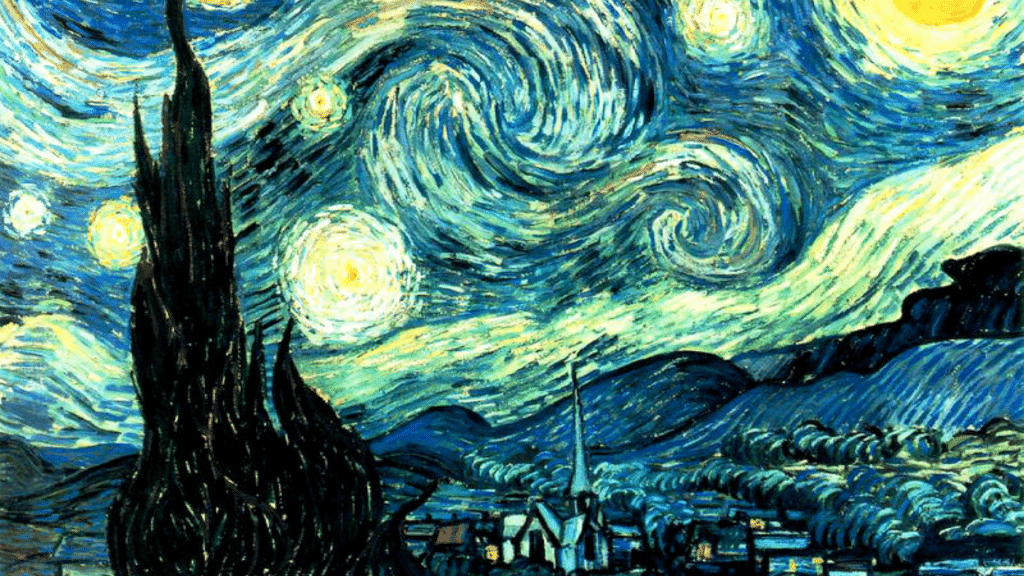
The Starry Night, 1889 by Vincent van Gogh
Flowing rhythm mimics natural movement through smooth, organic repetition. Unlike regular rhythm, this type feels more natural and less rigid, resembling the way elements move in nature, like waves, clouds, or growing plants.
The repetition curves and flows do not follow strict geometric patterns. Among the most famous rhythm examples in art, flowing rhythm creates some of the most captivating and emotionally resonant works.
Vincent van Gogh’s “The Starry Night” shows flowing rhythm through its swirling brushstrokes. See how the curved lines in the sky repeat in wave-like patterns that seem to dance across the canvas.
Notice how these swirling forms echo each other throughout the composition, creating a sense of movement that makes the night sky appear alive.
The repeated curved motifs flow together seamlessly, guiding your eye in circular, organic paths.
3. Alternating Rhythm
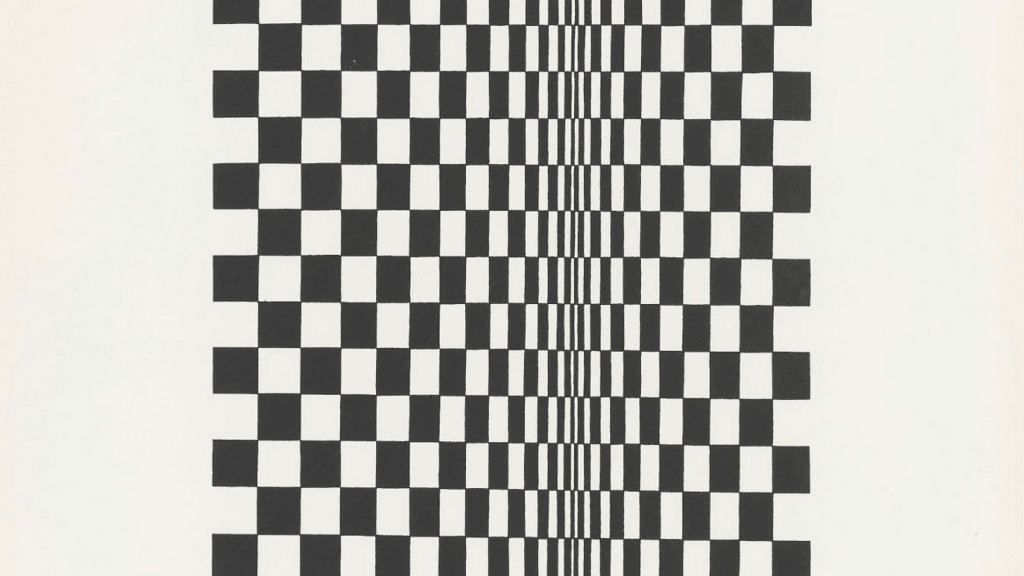
Movement in Squares, 1961 by Bridget Riley
Alternating rhythm occurs when two or more different elements repeat in a pattern, like an A-B-A-B sequence. This creates visual interest through variety while maintaining unity through the predictable alternation.
The contrast between the alternating elements adds energy to the composition.
Bridget Riley’s “Movement in Squares” demonstrates this through alternating black and white squares that create optical effects.
Observe how the squares alternate between dark and light in a checkerboard pattern, but with subtle variations in size and spacing.
Notice how your eye moves from black to white to black again, creating a visual rhythm that seems to pulse and vibrate.
This alternating pattern generates energy and movement, making the static painting appear to shimmer and dance before your eyes.
4. Progressive Rhythm
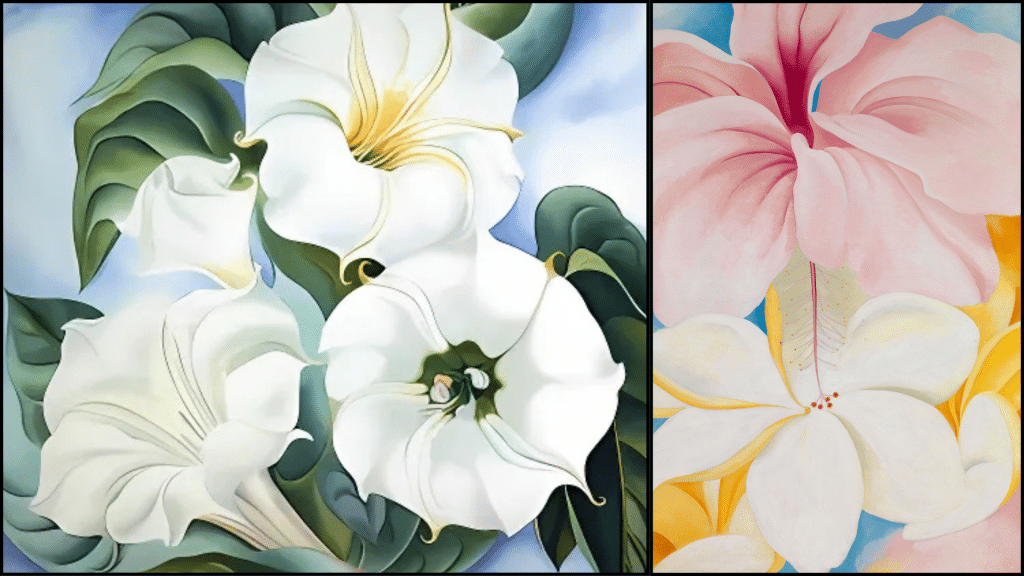
Left: Jimson Weed, 1936 by Georgia O’Keeffe Right: Hibiscus with Plumeria, 1939 by Georgia O’Keeffe
Progressive rhythm features elements that change or grow as they repeat. Rather than staying identical, the repeated elements gradually transform in size, color, intensity, or shape.
This creates a sense of development and movement, like a visual crescendo.
Georgia O’Keeffe’s flower paintings often demonstrate this through petals that gradually increase in size from the center outward.
Look at how the petal shapes repeat but grow progressively larger as they move away from the flower’s center. Notice how the colors often shift gradually from darker inner tones to lighter outer ones.
This progression creates a blooming effect that draws your eye into the heart of the flower while suggesting natural growth and expansion.
5. Random Rhythm
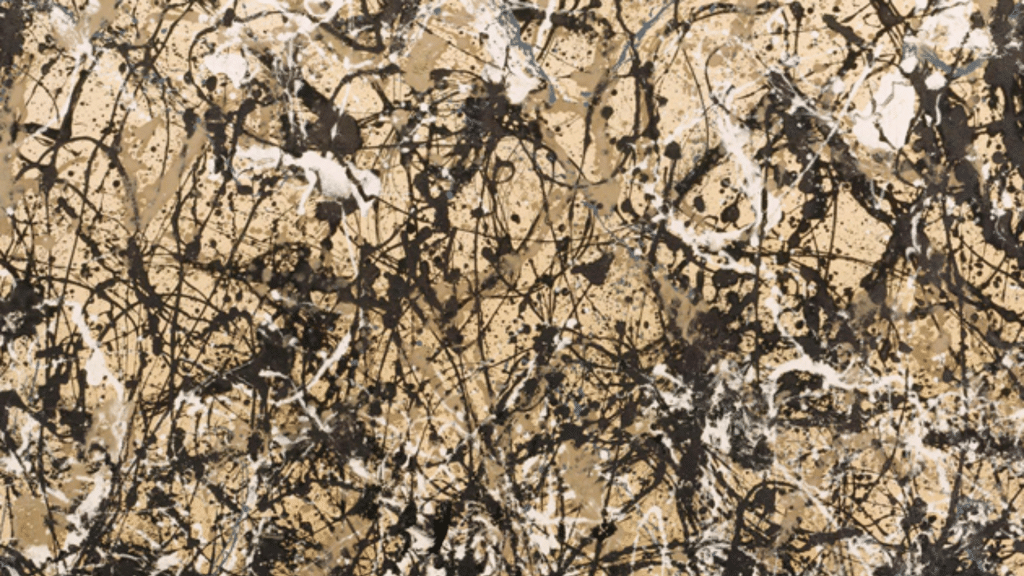
Autumn Rhythm (number 30), 1950 by Jackson Pollock
Random rhythm places repeated elements at irregular intervals with no set pattern. While it may appear chaotic, skilled artists carefully control the overall distribution to create balance and visual interest.
This type generates energy and spontaneity, making it one of the most dynamic rhythm examples in art.
Jackson Pollock’s “Autumn Rhythm” exemplifies this approach through its seemingly chaotic drip patterns.
Notice how, despite the apparent randomness, the overall distribution creates a sense of balance and flow.
The irregular placement of similar elements creates an energetic, lively surface that keeps your eye constantly moving and finding new relationships.
Techniques Used to Create Rhythm in Art
After seeing rhythm in famous artworks, the next logical question becomes: What specific methods do artists use to achieve these effects?
Understanding these techniques helps viewers recognize the deliberate choices artists make and appreciate the skill behind creating compelling rhythmic patterns.
1. Repetition
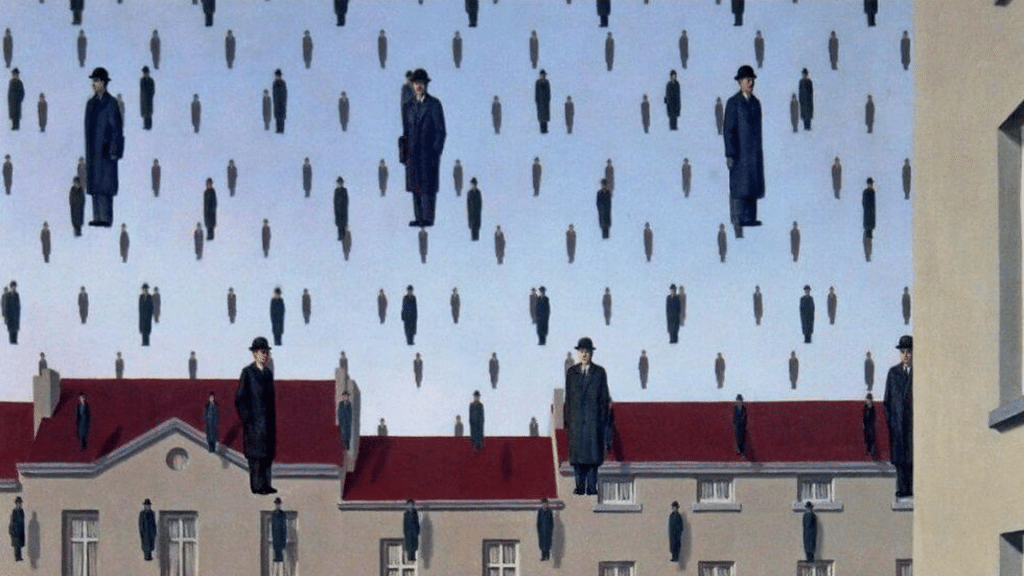
Golconda 1953 by Rene Magritte
Repetition forms the foundation of all rhythm in art. Artists consistently reuse elements like shapes, colors, lines, or textures throughout their work.
This technique taps into the brain’s natural pattern recognition system, creating predictable pathways that the eye automatically follows.
When viewers encounter repeated elements, they begin to anticipate where these patterns will appear next, creating a visual movement across the composition.
This predictability brings comfort and unity to the viewing experience, making even complex artworks feel cohesive and organized.
2. Variation
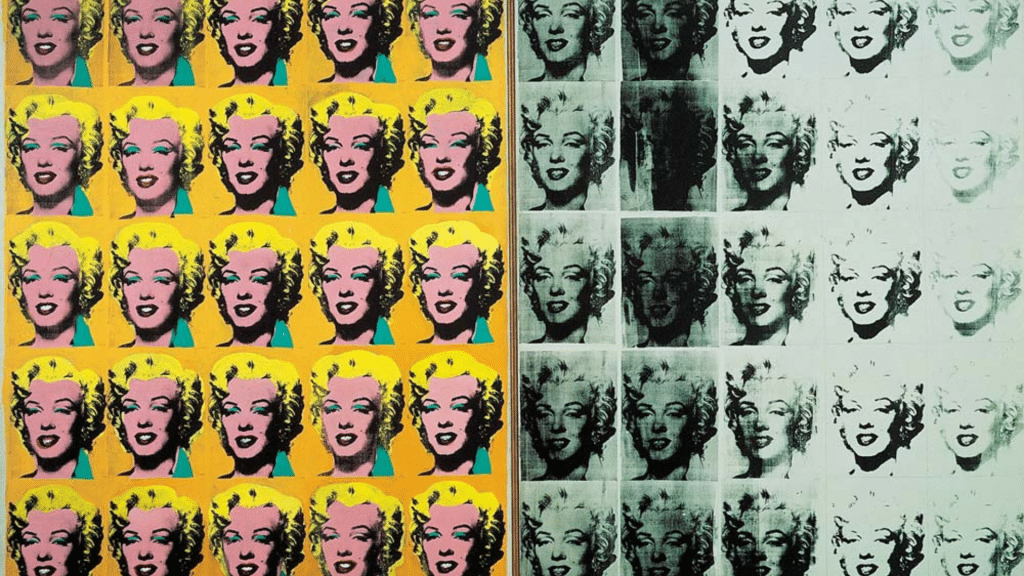
Marilyn diptych, 1962 by Andy Warhol
While repetition establishes rhythm, variation prevents it from becoming monotonous. Artists deliberately change aspects of repeated elements, making them larger or smaller, brighter or darker, or rotating their orientation.
This technique exploits our psychological need for both familiarity and novelty. The mind enjoys recognizing familiar patterns while finding unexpected changes, creating a pleasurable tension that keeps viewers engaged.
This balance between predictability and surprise activates feelings of satisfaction and curiosity, making the artwork more compelling to understand.
3. Contrast

The Calling of Saint Matthew, 1600 by Caravaggio
Contrast amplifies rhythmic effects by placing dramatically different elements next to each other. Light areas beside dark ones, large shapes next to small ones, or smooth textures against rough surfaces all create visual tension that enhances the rhythmic pulse.
Our eyes naturally gravitate toward dramatic differences, making contrasting elements function like visual accents in a rhythmic beat.
The stronger the contrast, the more pronounced the rhythmic effect becomes, creating energy that can make static images feel alive with movement and emotion.
4. Graduation

The Great Wave off Kanagawa, 1831 by Hokusai
Gradation involves creating smooth transitions between elements through gradual changes in size, color, value, or intensity.
This technique aligns with how we naturally experience movement and change in the real world.
Objects don’t typically appear and disappear instantly, but change gradually as they move through space. This familiarity creates a sense of flow that feels natural and effortless, guiding the viewer’s eye in a controlled manner.
The smooth transitions generate feelings of calm and harmony while creating depth and movement in flat compositions.
5. Pattern
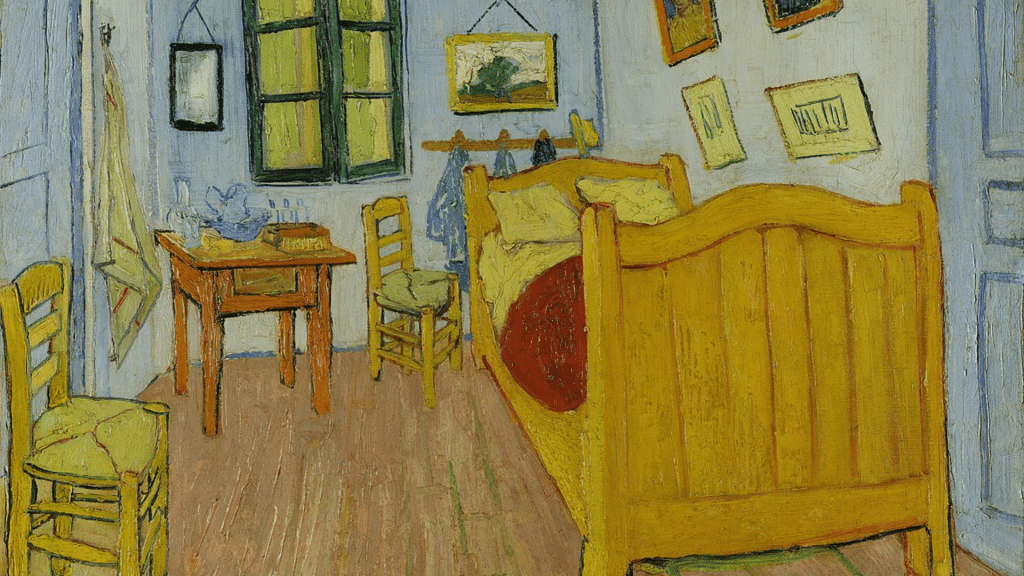
Bedroom in arles, 1888, by Vincent Van Gogh
Pattern-making uses repeated arrangements of multiple elements to establish complex rhythmic structures.
The human mind actively seeks patterns as a way to organize and make sense of visual information. When viewers encounter well-designed patterns, they experience satisfaction from successfully decoding the visual system.
Regular patterns create feelings of stability and order, while more complex patterns generate excitement and engagement as the mind works to understand the underlying structure.
This cognitive process transforms passive viewing into active mental participation.
6. Progression
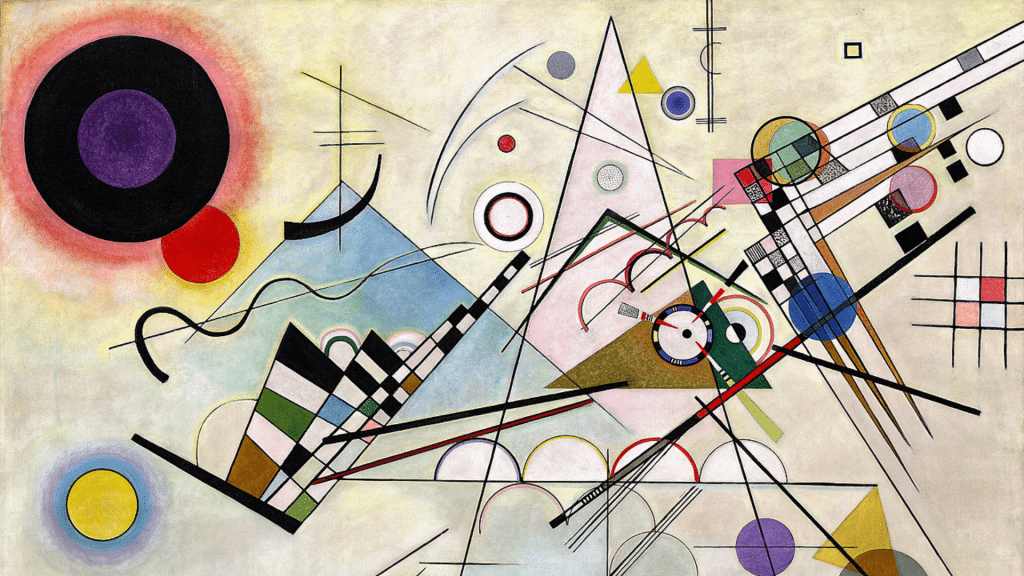
Composition VIII, 1923 by Wassily Kandinsky
Progression creates rhythm through systematic changes that build upon each other. Elements might grow progressively larger, colors might shift gradually through the spectrum, or shapes might transform step by step.
This technique capitalizes on our natural tendency to seek logical sequences and cause-and-effect relationships.
When viewers encounter progressions, they actively predict what comes next in the series, creating a sense of momentum and forward motion.
This predictive engagement generates satisfaction when expectations are met and excitement when they’re cleverly subverted.
7. Random Placement
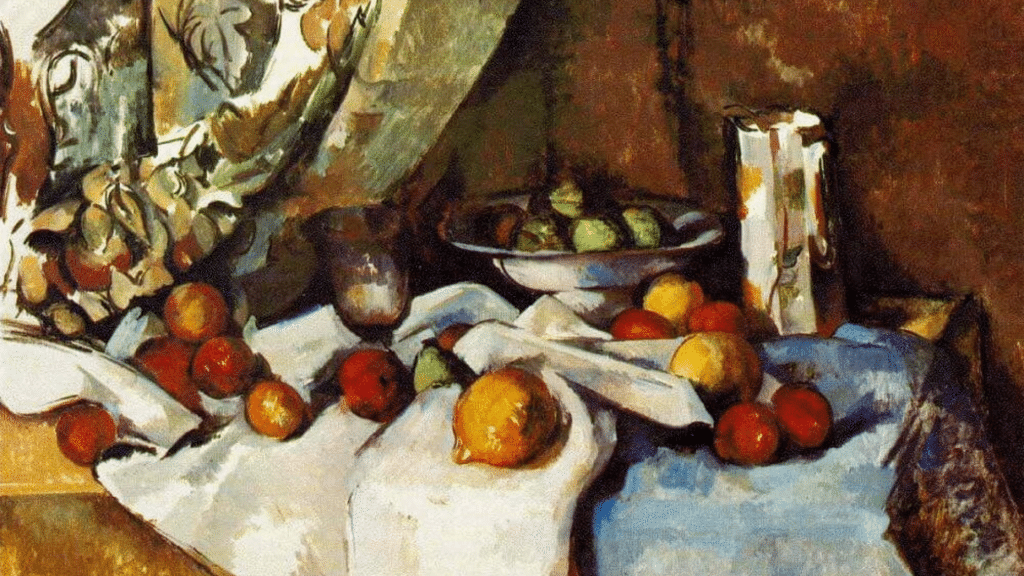
Still life with apples, 1898 by Paul Cezanne
Random placement creates rhythm through irregular repetition that appears spontaneous but is carefully controlled.
This technique mimics the statistical patterns found in nature, which humans have evolved to recognize and find appealing.
While the placement seems random, skilled artists ensure that the overall distribution creates balance and flow that feels natural.
The apparent randomness generates energy and excitement because viewers cannot predict where the next element will appear, keeping them actively engaged in exploring the composition while unconsciously recognizing the underlying order.
Final Takeaway
Rhythm stands as one of the most powerful tools artists use to create engaging, unified compositions.
Through careful repetition, variation, and arrangement of elements, artists guide viewers’ eyes, create emotional responses, and bring static images to life with implied movement.
Understanding rhythm enhances both the creation and appreciation of art.
When studying rhythm examples in art from master painters to contemporary artists, viewers develop a deeper appreciation for the deliberate choices that make artworks compelling.
The next time someone views an artwork, they can look for these rhythmic elements and see how artists use this principle to create their most compelling and memorable works.
Share your discoveries in the comments below – tell us which painting surprised you most with its rhythmic patterns, or post a photo of your own artwork where you’ve experimented with these techniques.

